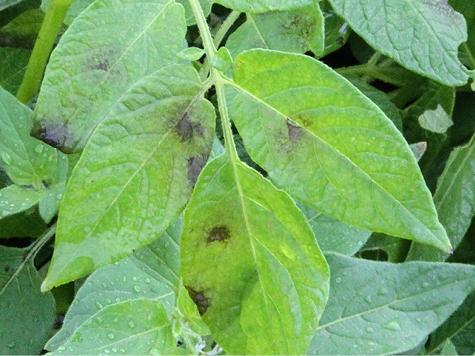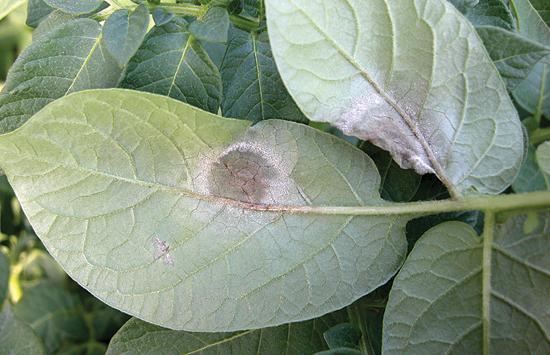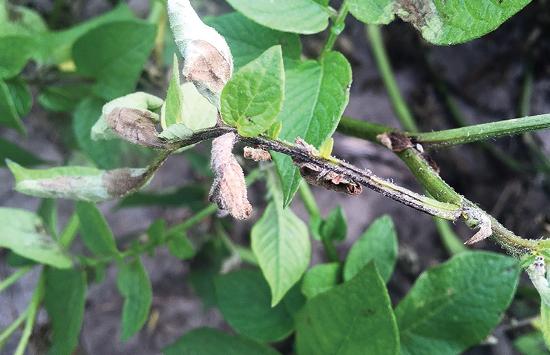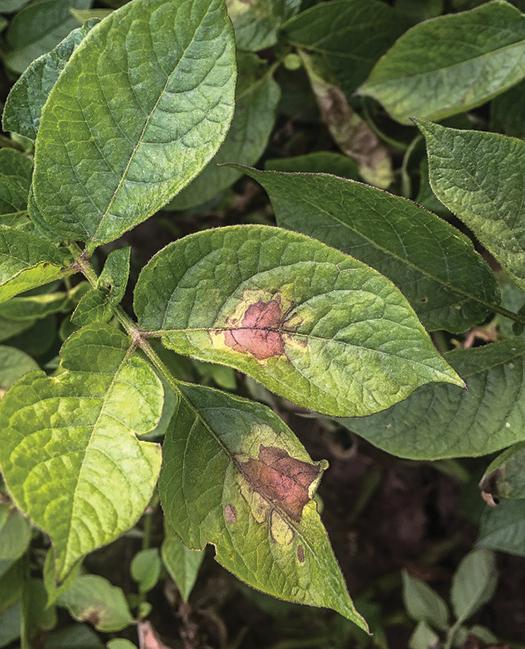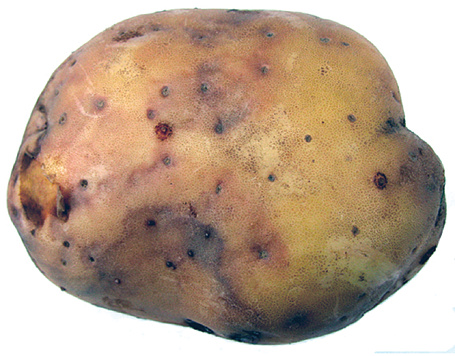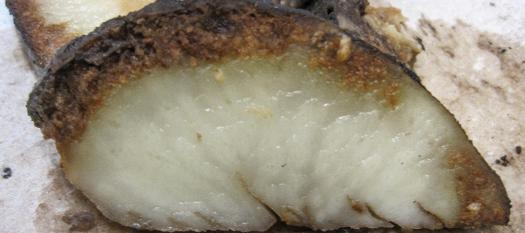图1. Initial symptoms of late blight are small, 浅绿色到深绿色, circular to irregular-shaped water-soaked spots.
The first symptoms of late blight in the field are small, 浅绿色到深绿色, circular to irregular-shaped water-soaked spots (图1). These lesions usually appear first on the lower leaves. 病变通常在叶尖或边缘附近开始发展,那里的露水保留时间最长.
在酷, 潮湿的天气, 这些病变迅速扩大, 深褐色或黑色病灶, 经常出现油腻(图2). Leaf lesions also frequently are surrounded by a yellow chlorotic halo (图3).
图2. Late blight lesions expand rapidly into large, 深褐色或黑色病灶, often
出现油腻.
图3. Leaf lesions frequently are surrounded by a yellow chlorotic halo.
The lesions are not limited by leaflet veins, and as new infections occur and existing infections coalesce, entire leaves can become blighted and killed within just a few days. The lesions also may be present on petioles and stems of the plant (图4).
图4. Late blight lesions may be present on petioles and stems of the plant, especially in new growth where moisture persists.
在活跃生长期间, 尤其是在凉爽的时候, 潮湿的天气, 在病灶边缘(图5)或沿叶柄(图6)可见白色霉变区。. This is the area where the late blight pathogen actively is producing spores. 随着天气变暖变干燥, 这些病变变得干燥, stop sporulating and become tan (图7).
图5. 在活跃的晚疫病生长期间, 尤其是在凉爽的时候, 潮湿的天气, a white mildew-appearing area is visible at the edge of the lesions.
图6. 活跃生长的晚疫病会导致叶柄上出现白色的霉变区域.
图7. Brown, 干 lesions can develop following warm and 干 weather.
A pale green to yellow border often surrounds the lesions. Severely infected fields often produce a distinct odor.
Late blight infection of tubers is characterized by irregularly shaped, 皮肤上轻微凹陷的区域,大小和颜色从棕色到紫色变化很大(图8)。. These symptoms may be less obvious on russet and red-skinned cultivars.
图8. Late blight infection of tubers is characterized by irregularly shaped, slightly
凹陷的区域可以变化很大,从棕色到紫色,大小不一
皮肤.
棕褐色到红棕色, 干, 在变色区域的皮肤下发现粒状腐烂,通常延伸到块茎不到1 / 2英寸(图9)。. The extent of the rotting in a tuber depends on the susceptibility of the cultivar, temperature and length of time after the initial infection.
图9. Late blight causes a tan to reddish-brown, 干, 在变色区域的表皮下发现粒状腐烂,并延伸到块茎中.
The margin of the diseased tissue is not always distinct but can be, 特别是在冷藏温度下储存的马铃薯种子(图10). 然而, 晚疫病感染组织和健康组织之间的边缘常以延伸到块茎健康果肉的棕色指状标志.
图10. The margin of the diseased tissue is not always distinct but can be, particularly in seed potatoes that have been stored at cold storage temperatures
Infections of other tuber rot organisms such as soft rot bacteria, 粉红腐病或漏病经常利用晚疫病疫区作为感染场所,其进展往往比晚疫病更快. 使诊断变得困难.
可以通过显微镜检查受感染的叶片或块茎的孢子样来确定晚疫病的阳性鉴定. 非产孢样品的鉴定和晚疫病基因型的鉴定可以通过PCR来完成. 这项服务在NDSU提供.
一些晚疫病基因型已被证明对杀菌剂甲螨灵有抗性. 当晚疫病被证实时, 确定晚疫病基因型对于确保有效的化学处理至关重要. 联系您的本地分机 office for current information on fungicide-resistant late blight genotypes.
